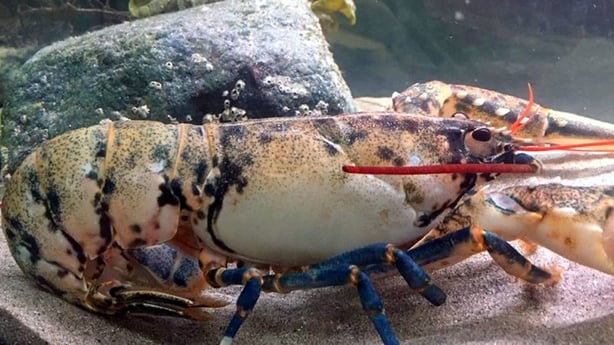Staff at Achill Experience Aquarium in Co Mayo are trying to work out why their rare Albino lobster is turning blue.
It is estimated that only one in 100 million lobsters are white or albino.
Aquarist Kevin Garvin, explained that the lobster 'Charlie' was discovered by a fisherman Charlie O'Malley at near the village of Dumha Acha in 2017, and has been in the care of the aquarium since.
The beach itself where Charlie was found had disappeared for 30 years but reappeared.
The albino lobster, like all lobsters, moult every year and shed their outer shell in order to grow. But in the last three to four years, every time Charlie moulted, he went through an odd change in that he is starting to turn blue.
"Every time he has done so the shell has turned bluer and bluer," Mr Garvin said.
Mr Garvin explained that generally a lobster should be a dark black or dark navy colour, and the reason they can come in a variety of different colours is due to a rare genetic mutation in the cells.
It is also as a result of proteins, as lobsters can under produce proteins being eaten in the diet, which results in an orange lobster which is a one in 30 million change.
For blue lobsters, which are a one in two million chance, they over produce proteins.
In Charlie's case, he was not producing any at all, but was doing very well and getting larger every year, with Mr Garvin describing him as a regular healthy lobster.
"Somewhere down the line he starting to produce pigment, we're not too sure about the process, it could be due to his diet or age, but perhaps other environmental circumstances but at the moment, it's a little bit of a mystery," he said.
He added that due to the usual dark colour of lobsters, they can hide in darker environments but an albino lobster does have that same protection and sticks out easily in darker environments. Mr Garvin said that this was another reason albino lobsters were rare with their numbers being reduced due to predators seeking them out.
"To find one is a very unique event."
He explained that lobsters live on average 30 to 50 years, but some have lived up to 80 years, while one of the oldest recorded lived to 140 years of age.

Mr Garvin explained that Charlie is not the only rare animal at the aquarium, as there is another rare lobster 'Rusty' who is orange in colour.
He was caught in Co Galway within two weeks of Charlie. He explained that Rusty will stay his orange colour and has been that colour all his life.
He added that the lobsters are kept separated at the aquarium as they are not known to be sociable, and in some cases can be cannibals, so they have their own environment and prefer solitude. They also enjoy having hiding places and dark areas.

